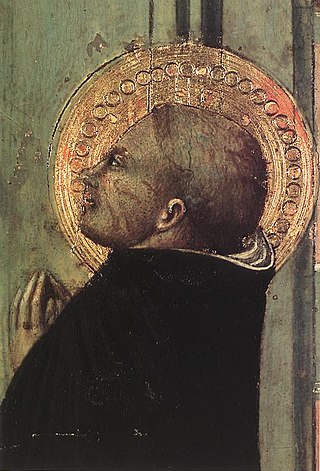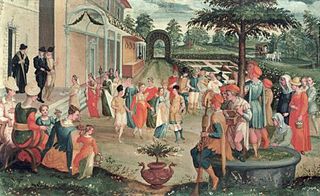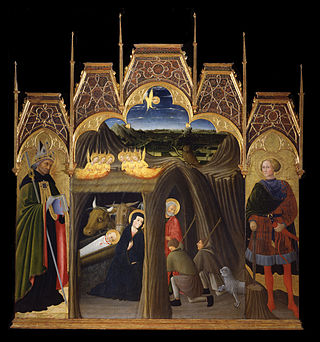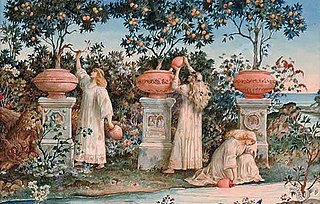Related Research Articles

The Sienese School of painting flourished in Siena, Italy, between the 13th and 15th centuries. Its most important artists include Duccio, whose work shows Byzantine influence, his pupil Simone Martini, the brothers Pietro and Ambrogio Lorenzetti and Domenico and Taddeo di Bartolo, Sassetta, and Matteo di Giovanni.

For the village near Livorno, see Sassetta, Tuscany

Sano di Pietro or Ansano di Pietro di Mencio (1405–1481) was an Italian painter of the Sienese school of painting. He was active for about half a century during the Quattrocento period, and his contemporaries included Giovanni di Paolo and Sassetta.

Matteo di Giovanni was an Italian Renaissance artist from the Sienese School.

Cristoforo Rustici, known as il Rusticone, was an Italian painter active in Siena who is known for his religious compositions and allegorical scenes representing the twelve months.

Jacopo di Mino del Pellicciaio was an Italian painter, active in Siena.

The Master of the Osservanza Triptych, also known as the Osservanza Master and as the Master of Osservanza, is the name given to an Italian painter of the Sienese School active about 1430 to 1450.

Bernardino Fungai was an Italian painter whose work marks the transition from late Gothic painting to the early Renaissance in the Sienese school. He maintained a fairly archaic style in his works, which are mainly of a devotional nature.

The Basilica dell'Osservanza is a church on the outskirts of Siena, region of Tuscany, Italy.

Cecco di Pietro was an Italian painter of the Pisan School. While his date of birth cannot be confirmed, there is some mention of a Cecco Pierri working with the painter Paolo di Lazzarino in 1350. If this was a reference to di Pietro, then his date of birth can be placed around 1330.
Francesco Nasini was an Italian painter of the Baroque period, active mainly in towns outside of Siena, Italy.
Lorenzo Rustici (1512–1572) was an Italian painter of the Renaissance period, active mainly in his native city of Siena, Italy. He was also known as Il Rustico or Lorenzo di Cristoforo Rustici. His sons were Vincenzo and Cristoforo Rustici. A specific contract for his work in painting the ceiling of the Loggia della Corte de Mercanti in Siena is known. He painted in the church of San Pietro alla Magione in Siena.
Mino di Graziano (1289–1323) was an Italian painter, active in Siena. He is said to have painted frescoes in the Sala del Consiglio of the Palazzo Pubblico of Siena.

The Palazzo Chigi all Postierla, but sometimes referred also to as Chigi-Piccolomini or Piccolomini-Adami is a Renaissance style urban palace localized on Via del Capitano #1, corner Piazza Postierla, in the Terzo di Città, in the city of Siena, region of Tuscany, Italy. The palace is up the street from the Palazzo del Capitano del Popolo, Siena.
Cristoforo di Bindoccio, also called Cristoforo del Maestro Bindoccio or Cristofano Malabarba, was an Italian painter active in Siena and Pienza. He worked with Francesco di Vannuccio and Meo di Piero. There is an altarpiece attributed the Crostoforo and Meo di Piero at the Barnes Foundation.
Meo di Pero, also called Meo di Piero was an Italian painter active in Siena in a Gothic style. He worked in the studio of Cristoforo di Bindoccio. All the latter paintings are generally co-attributed to Meo, since no independent work is known.

The Museo d'Arte Sacra della Val d'Arbia is a small museum of religious art in Buonconvento, in the Val d'Arbia to the south of Siena, in Tuscany in central Italy. It contain a number of paintings by important artists of the Sienese School, among them Duccio di Buoninsegna, Sano di Pietro and Pietro Lorenzetti. The museum is housed in the Palazzo Ricci Socini, close to the parish church of Santi Pietro e Paolo.

Pietro di Giovanni D'Ambrogio was an Italian painter of the Sienese school.

Ricciardo Meacci was an Italian (Sienese) painter from the school of "Purismo" who came under the influence of the "Pre-Raphaelite" movement. He received several commissions for mural paintings, examples of which survive in the grand buildings of his native city of Siena. He is more widely-known, however, for his compressed but florid watercolour and gouache images of Christian devotional subjects, and moralized, allegorical scenes upon classical and romantic themes, original in composition but making reference to the Sienese quattrocento. These formal paintings, often conceived as triptychs, were cased in ornamental frames of modelled plaster, gilt, and applied pilaster arcading, and with openwork carving or finials, combining techniques and materials after the manner of the Arts and Crafts movement. For such works he had patrons among the royal houses of Europe, and examples are in the British Royal Collections. His watercolour studies of architectural corners and spaces in Venice and Florence are populated by incidental figures in daily costume.
References
- ↑ Thomas, Anabel (2023). The Art and Government Service of Francesco di Bartolomeo Alfei (c. 1421 - c. 1495) Visual Propaganda and Undercover Agency for the Republic of Siena. Amsterdam University Press. ISBN 978-90-485-5626-7.
- ↑ Garollo, Gottardo (1907). Ulrico Hoepli (ed.). Dizionario biografico universale. Editore Libraio della Real Casa, Milan. p. 60.
- ↑ Basilica Osservanza website.
- ↑ Falcone, Maria (2010). "La giovinezza dorata di Sano di Pietro. Un nuovo documento per la 'Natività della Vergine' di Asciano". Prospettiva (138): 28–34. ISSN 0394-0802.
- ↑ "Sano di Pietro's Nativity of the Virgin | The Mary's first day". Hypercritic. Retrieved 2023-11-29.
- ↑ Documenti per la storia dell'arte senese, Volume 2, by Gaetano Milanesi, 1854, page 421.
- ↑ Documenti per la storia dell'arte senese, raccolti ed illustrati. by Dottore Gaetano Milesi, 1854, page 329.
- ↑ Quoted from Oxford Grove Art and cited in .
- ↑ Opera Omnia Francesco di Bartolomeo Alfei, Maestro dell'Osservanza by Grande Encyclopedia Multimediale dell'Arte.
- ↑ Dizionario Biografico degli Italiani Treccani Encyclopedia- Volume 2 (1960) by Maria Leuzzi.